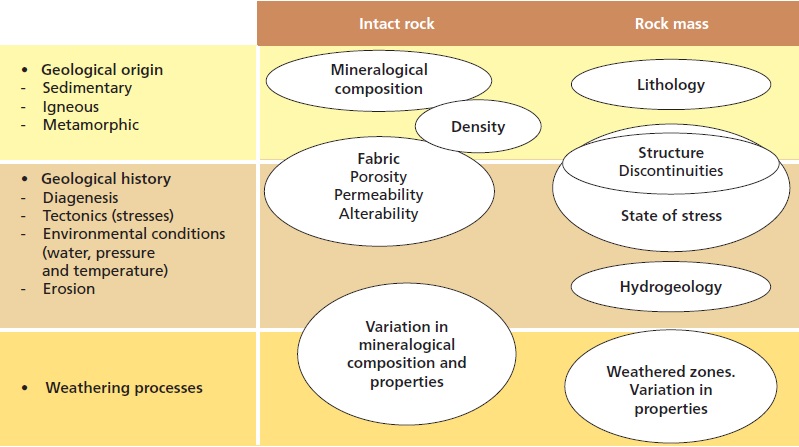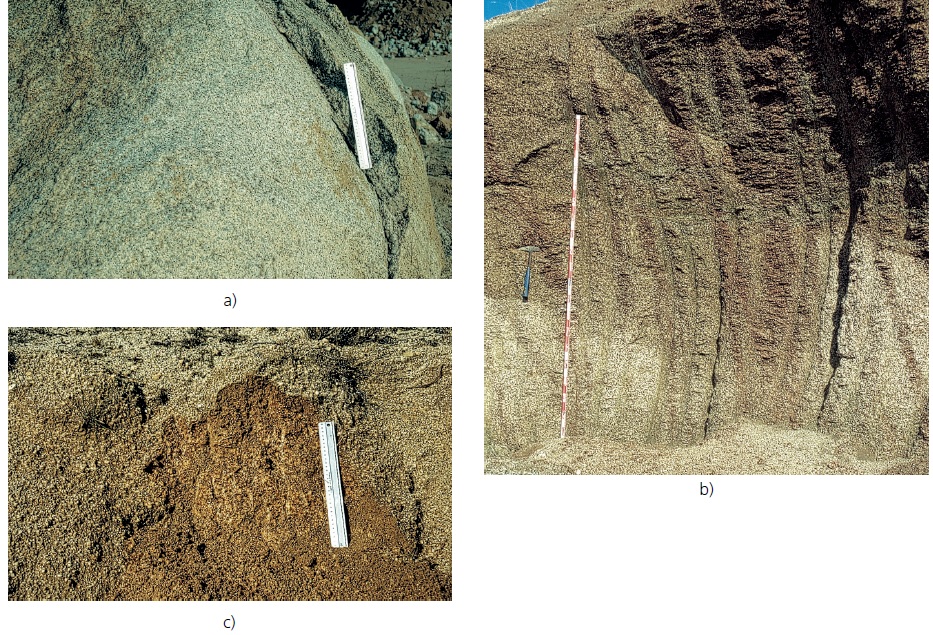Intact rock

What is intact rock?
Intact rock is rock material with no joints or discontinuities. Although intact rock is considered to be a continuum, its behaviour is often heterogeneous and anisotropic related to its fabric and mineral micro-structure. In mechanical terms, it is characterized by its specific weight, strength and deformability.

Intact rock characterisation
Aspects to be described in the field are:
— Identification.
— Weathering.
— Uniaxial compressive strength.

Identification
Visual identification of a rock is established from its composition and the texture or geometric relationship of its minerals and grains. If it is possible to deduce the genetic characteristics from mineral paragenesis, chemical composition, the form and structure of the deposit and its temporal and spatial relationships with other rocks, then these aspects should also be added to the description.
The most practical observations are:
— Mineralogical composition.
— Grain or crystal shape and size.
— Colour and transparency.
— Hardness.
In order to observe these properties accurately, the rock has to be cleaned and the weathered surface layer removed. Depending on the type of rock, other aspects may be determined, such as the presence or absence of cleavage. Lithological classification of the rock can be made from its mineral composition. If dimensions permit, the most common rock forming minerals can be identified from samples, using a magnifying glass. Detailed identification of minerals requires a petrographic study, commonly requiring the use of a thin section; this should always be carried out in cases of doubt regarding mineral identification.
Grain size refers to the average size of the minerals or fragments of rock making up the intact rock. Estimation of grain size is normally done visually either with a ruler or with the aid of grain size comparators. A hand-held magnifying glass is useful for fine-grained rocks. The size of the mineral particles making up the rock may be homogeneous (equigranular rocks) or show considerable variation (heterogranular rocks).
| Description | Grain size | Equivalent soil types |
| Coarse-grained | >2 mm | Gravel |
| Medium-grained | 0.06–2 mm | Sands |
| Fine-grained | <0.06 mm | Silts and clays |
The colour of a rock depends on the minerals it is composed of. Some minerals have a distinctive colour but this is often modified by certain substances or impurities contained in them.
Colour description is similar to that used for soils and comprises a main colour, a secondary colour and their intensity (for example, pale greenish-grey granite). In order to avoid any subjectivity in the description, rock colour charts should be used.
Observations must be carried out on fresh rock after the altered surface layer has been removed.
When the rock has not been affected by weathering processes and presents its original characteristic colour, it is defined as fresh rock. Colour variations in the outcropping rock indicate that the rock material has undergone weathering processes. Such variations may affect all the minerals involved or only a few of them, an aspect that should be reflected in the description.
Hardness is a property directly related to strength, which depends on mineralogical composition and the degree of weathering of the rock material. Description is qualitative and rock density and strength are generally used as criteria, with grade 1 indicating a less dense and hard rock (γ =15 kN/m3 and σc =5 MPa) and grade 14 for the most dense and hard rock (γ =27 kN/m3 and σc =180 MPa). The Moh’s scale is used to evaluate mineral hardness, with a value of 1 given to the softest material (talc) and a value of 10 to the hardest (diamond).
Weathering intact rock
The degree of weathering of the rock is an important consideration as it has a permanent effect on its mechanical properties. As the weathering process progresses, the porosity, permeability and deformability of the rock material change at the same time as its strength diminishes.
When describing the degree of weathering, four basic terms are used: fresh, discoloured, disintegrated and decomposed; these terms may be followed by other qualifying terms e.g. “wholly” or “partially”.

the rock; b) rock disintegrated into soil with the original fabric still intact; c) decomposed rock, with decomposed
minerals and loss of original texture. The scale shown is 30 cm length in photographs a) and c) and 2 m in b).
The principal agent of weathering is climate, so weathered rock will therefore vary in appearance according to different climatic regions. Figure 1 shows some examples of different degrees of weathering in granitic rock. Weathering processes affect different types of rock unevenly, the greater the exposure time to atmospheric agents, the more intense these processes will be.
| Term | Description |
| Fresh | No visible sign of weathering of the rock material. |
| Discoloured | Change in colour of the original rock material. The degree of change from the original colour should be indicated. If the colour change is confined to particular mineral constituents this should be mentioned. |
| Disintegrated | The rock is weathered to the condition of a soil in which the original fabric is still intact. The rock is friable but the mineral grains are not decomposed. |
| Decomposed | The rock is weathered to the condition of a soil in which the original material fabric is still intact, but some or all of the mineral grains are decomposed. |
Strength
Intact rock strength can be estimated at the outcrop from field indexes or from correlations with data obtained from simple in situ tests, such as the Point Load Test (PLT) or the Schmidt hammer.
The range of rock strength can be roughly estimated from field indexes.
The point load test (PLT) fails a rock specimen between two platen points, from which a point load strength index Is is obtained that can be correlated with uniaxial compressive strength. The Schmidt hammer test gives a rebound number resulting from the application of the hammer to the rock of interest, from which the uniaxial strength can be estimated. For both these tests, it is recommended that a high number of measurements be taken and that a statistical analysis be carried out on them. With the strength values obtained from these methods, intact rock can be classified according to the criteria in Table 1.
| Uniaxial compressive strength (MPa) |
Description |
| 1–5 | Very weak |
| 5–25 | Weak |
| 25–50 | Moderately hard |
| 50–100 | Hard |
| 100–250 | Very hard |
| >250 | Extremely hard |




